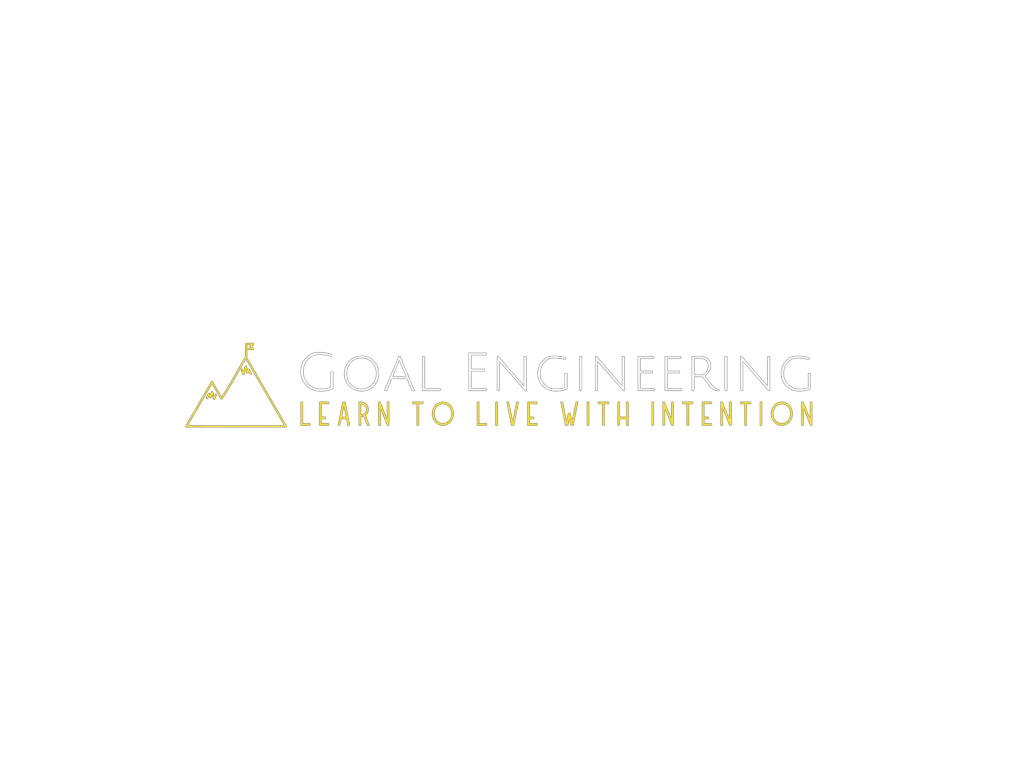A couple of weeks ago, I published my big goal-setting how-to guide, and I can’t stop thinking that something was missing from it. I realized that finding, refining, and tracking are good, but it all goes to waste unless you know the tricks to achieving goals.
I’ve learned quite a few tips for this, but here are just three things that will make you better at achieving goals:
- Make it fun
- Make it easy
- Cut it in half
I’m really excited to share these ideas with you because I have real, recent, first-hand experience with them! But let’s start with some word math to get a better understanding of what we’re really after here.
Word Math
How about we begin with some definitions, courtesy of Google, which uses Oxford Languages:
- Make: form (something) by putting parts together or combining substances; construct; create.
- Achieving: successfully bring about or reach (a desired objective, level, or result) by effort, skill, or courage.
- Goals: the object of a person’s ambition or effort; an aim or desired result.
- Inevitable: certain to happen; unavoidable.
So we start with:
Make Achieving Goals Inevitable
Which, when substituting in our “word equations” and simplifying gives us:
Form by putting parts together to successfully bring about the desired objective of a person’s ambition or effort in a way that makes them certain to happen; unavoidable.
And to simplify even further for more clarity:
How do I form my plan to accomplish my objectives in a way that makes them certain to happen?
Now let’s dig into these three ways to find out the answer to this question so you can achieve your goals, reach your dreams, and become your best self!
1. Make it Fun
Jon Acuff’s book Finish explains this and many other crucial principles for beating the biggest enemy to your goals-perfectionism.
In chapter four of the book, he explains that perfectionism lies to you by telling you that if your goal is fun, it doesn’t count.
You can see this in your health goal because most often, you think to be healthy means running alone. But just like most people that quit a goal, you fail at it because you don’t ask yourself a simple question:
“Do I enjoy running?”
What you fail to realize and admit to yourself, because of perfectionism, is that your walk with a friend, dance class, or soccer game counts as exercise!
In other words, you don’t have to run to be healthy. You can do the exercise you actually enjoy. The same goes for eating healthy foods. If you hate kale as much as I do, then don’t eat it!
This also applies to the other pillars of life too. If you like a particular spiritual activity more than others, set that as your goal. Would you rather take your son hiking than play dinosaurs with him? Go for it!
How I’ve Seen This Help Me Get Better at Achieving Goals Recently
Between the busyness of graduate school, starting this blog, taking care of two kids while preparing for a third, and buying a new car, I’ve been having a hard time exercising lately.
Although I do like running, I was pushing myself to do it without much success. I realized that I wasn’t letting it be fun anymore and needed the element of fun back just to get started.
So I did the only logical thing a 30-year-old who grew up in the 90s would do and got back into rollerblading. Just last week, I went three times and even felt good enough to get back on the treadmill again!
I’ve also lost at least three pounds since starting this habit!
How You Can Practice Making Your Goals Fun
The first step to finding what you enjoy is simply to ask yourself. Here are a few questions to journal about to get started:
- What are my spiritual strengths? Do I prefer to grow by reading, meditation, teaching, service, or something else?
- What do I have in common with my spouse and kids that I would have fun doing with them?
- Which part of the workday do I enjoy the most? What past job of mine was my favorite, and why?
- What exercises do I like to do? When I was a kid, what did I do to be active? Which healthy foods are my favorite? How can I make sleep more enjoyable? Here’s a hint for that last one: get a new mattress!
I’ve found that the most important thing in each of these is to test your ideas by doing them. You will get information on what you like much faster if you try a lot of different things at first, then reflect.
An excellent pattern to accomplish this would be:
- Spend an hour one Sunday afternoon journaling about the questions I’ve asked above and others you come up with to discover what goals you would enjoy.
- Make a plan to try one thing each day of the week ahead.
- Each time you do one of your activities, immediately afterward record in your journal a brief description of what you felt while doing it. What feelings did you have? What were you thinking about? How much pain did you feel, and where?
- The following Sunday afternoon, review your list and eliminate the ones that were the least enjoyable to find the methods you should focus on to make achieving your goals more likely!
2. Make it Easy
Shawn Achor explains in his book The Happiness Advantage how, after discovering the science of a growth mindset, he wanted to test it on himself by learning to play the guitar.
Following the commonly believed notion that it takes 21 days to build a habit, Achor created and printed a chart to check off each day he practiced.
How do you think he did?
A few weeks later, frustrated by seeing only four checkmarks and a whole lot of blanks afterward, the frustrated author pulled the sheet off the wall.
What he failed to realize, though, was the real power of the seemingly insignificant 20 seconds between him and beginning to practice. Shawn was keeping his guitar in the closet, which took about 20 seconds to get.
But after some research taught him that willpower isn’t as reliable as we might think, he tried a new experiment.
This time, it was in the form of a $2 guitar stand and simply involved placing his guitar on the stand in the middle of the room.
Three weeks after this new experiment began, Achor proudly looked at his new habit-tracking sheet, this time filled with checkmarks on all 21 days.
The secret is in what Achor now calls the 20-second rule.
How I’ve Seen This Help Me Get Better at Achieving Goals Recently
A constant struggle for me the last few years has been taking care of our lawn. Because we rent, I’ve had to borrow a lawnmower and other tools to mow and edge, and it’s always been difficult until recently.
My in-laws own the home, and they live just down the street. It seems like such a small effort to walk down the street and get their mower.
But I did the math, and because the yard is small enough, it almost doubles the time it takes to mow the lawn because I had to get the mower.
Forget 20 seconds, the time between me and starting to mow was 20 minutes!
It was a constant source of contention until a couple of weeks ago when I finally bought my own lawnmower and weed whacker. Now that those are both in the garage, I have no problem mowing and edging every week.
Our yard now looks great, and I’ve even had family members complimenting me on it, which has never happened before!
How You Can Practice Making Your Goals Easy
Again, the best way to tackle this component of achieving goals is to ask yourself a few questions. Try this pattern out yourself:
- How long does it currently take me just to get to the point of starting my goals?
- What events do I have to accomplish before I can begin working on my goal?
- What can I do to eliminate those events so they aren’t a problem anymore?
You can journal about this with each of your faith, family, finance, and fitness goals to take advantage of the 20-second rule and have maximum success.
Here’s an example of how I once used it to help me start working immediately each morning instead of getting distracted:
- Although I didn’t ever record the amount of time it took, I often took 10 minutes from the time I got to my home office and starting to actually work.
- Open my laptop, plug it into my second monitor, plug in my headphones, plug in my external keyboard and mouse, close tabs for social media and email.
- The solution, I discovered, was to set the laptop up, open and connected to everything, the night before. I also closed all tabs I had open on social media or email and left the tab for work open.
After all of this, I just put my computer into sleep mode so all it would take is a 3-second mouse click to wake it up and start working!
3. Beat Perfectionism by Cutting Your Goal in Half
One of the most common issues I see with people’s goals is that they are too big. That’s not a problem, audacious aims are admirable and even achievable, but the timeline is usually what trips people up.
You might have had the experience yourself of getting excited about a big goal only to realize too late that it was too much for you to handle. It’s not fun, and it can discourage you from setting goals in the future.
But that’s where another great idea from Jon Acuff’s book Finish can save the day. This time, it’s about lowering your expectations to improve your chances of success.
“But I have so many goals!” You might argue. Isn’t it better to accomplish half of your goal or none of it, though? Because when you try to push too hard, you’re setting yourself up for failure.
In a study by Roger Buehler, he identified how we overestimate how long a task will take us. He asked seniors in college to guess how long it would take them to finish their honors thesis.
Most of them assumed they’d need 34 days to complete the project. The actual amount of time it took them was almost double, however, at 56 days.
Knowing this from the start, however, lets you set yourself up for success. This is because you can plan for unforeseen events or the unanticipated difficulty of hitting your target in the right timeline.
Cutting a goal in half is simple. You can either slash the number you’re shooting for into two or halve your timeline.
How I’ve Seen This Help Me Get Better at Achieving Goals Recently
One of my biggest goals right now is this website.
Initially, I did the math and figured that by publishing three times per week, I could reach 100 posts by the end of 2020. That was exciting, but the more I considered it, the more difficult it sounded.
Realizing I might want to pace myself better, I looked at the numbers one more time. If I cut it in half and just finished 1.5 posts per week, I’d still have 50 posts by the end of the year!
I modified it slightly and am going for two a week, but still, my success rate is much higher now that I cut my goal in half.
Plus, I know the math and can see that I’m still going to do something amazing even though it’s only half of what I could have done.
And let’s be honest, I’d be way less likely to accomplish it if I hadn’t cut it in half. In reality, it’s not that 100 is better than 50. It’s more like 50 is better than the 0 I would get if I’d pushed myself too hard!
How You Can Practice Cutting Your Goals in Half
In Finish, Acuff gives a great pattern for practicing this method to make achieving goals more likely. These are the steps he recommends:
- Review an old goal that you tried to accomplish. Ask yourself if it was too big and how you did at it.
- Make sure that you’ve got your current goal tied to a number. Do you want to lose 10 pounds? Is it one hour of quality time with your kids a day? Or are you trying to reach an income of $100,000 a year?
- Cut your number in half. If you can’t do that, double your timeline.
- Talk with your spouse or a close friend about your goal and ask them if they think it’s too much.
- If you’re still struggling with perfectionism, answer the question, “what’s the worst that could happen?” in your journal.
Now It’s Your Turn to Use These Steps to Get Achieving Your Goals
If you want to make your plan to accomplish your goals in a way that makes them certain to happen, you just need to make them easy and fun and cut them in half!
A lot of the ways to make that happen involve journaling about specific questions. I recommend you use a Sunday afternoon or some other free time to accomplish this so you can take advantage of these principles.
I’ve personally tested each of these ideas out, and I know from experience that they will work. They’ve helped me use the power of goals to change my life, and I’m confident that they will do the same for yours too!





